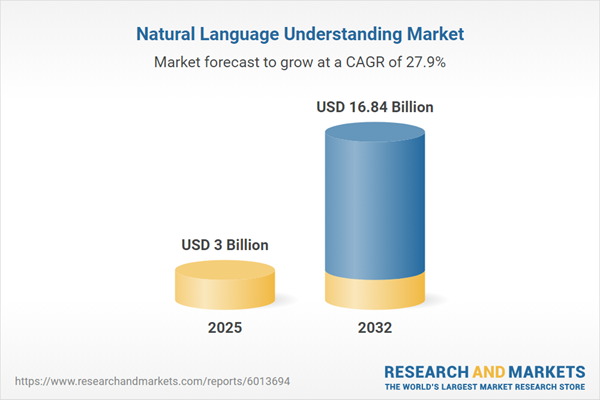Speak directly to the analyst to clarify any post sales queries you may have.
Natural language understanding (NLU) is reshaping how enterprises manage data, streamline processes, and enable efficient collaboration across teams. Senior decision-makers are leveraging NLU to drive operational agility and align digital transformation efforts with business objectives.
Market Snapshot: Natural Language Understanding Market Growth
The natural language understanding market is experiencing significant momentum as organizations pursue next-generation AI architectures for more effective unstructured data management. Estimated at USD 2.34 billion in 2024, this sector is projected to reach USD 3 billion next year, indicating robust demand. A compound annual growth rate (CAGR) of 27.91% through 2032 points to substantial future expansion, with forecasts at USD 16.84 billion. Growth is being propelled by increased investment from sectors such as financial services, healthcare, and government, which rely on NLU to digitize workflows, improve stakeholder engagement, and address intricate compliance needs. With enterprises prioritizing digital maturity and improved customer interactions, NLU is cementing its role as a strategic enabler within operational frameworks.
Scope & Segmentation: Key Components Fueling Market Evolution
- Component: Managed and professional services support consulting, deployment, lifecycle management, and ensure alignment with business goals. Adaptive software platforms accommodate both public cloud and on-premises environments, promoting operational efficiency.
- Deployment Mode: Flexible deployment options include public cloud, private cloud, and on-premises solutions. These options address organizational needs for scalability and compliance across different regions and regulatory landscapes.
- Model Type: Diverse models—neural, hybrid, rule-based, and statistical—integrate easily with legacy or modern systems, supporting evolving regulatory and operational requirements.
- Application: NLU powers solutions such as chatbots, virtual assistants, machine translation, content localization, service automation, and sentiment analysis, enhancing process efficiency and customer interactions.
- Organization Size: Scalable NLU solutions meet the needs of both large enterprises and small to midsize businesses, aligning with various levels of digital maturity and specific change management targets.
- Industry Vertical: Key industries—including banking, financial services, insurance, healthcare, government, IT, telecom, retail, and ecommerce—utilize NLU to improve workflow and address compliance requirements.
- Region: Adoption is influenced by the regulatory and business contexts of major economies such as the United States, Canada, UK, Germany, China, Japan, Brazil, UAE, and Australia. This informs localization and strategy across North America, Europe, Latin America, Middle East, Africa, and Asia-Pacific.
- Key Companies: Leading solution providers are Google LLC, Microsoft Corporation, Amazon.com Inc., IBM Corporation, Apple Inc., Baidu Inc., Meta Platforms Inc., Alibaba Group Holding Limited, Tencent Holdings Limited, and Oracle Corporation.
Key Takeaways for Senior Decision-Makers
- Implementation of natural language understanding enhances organizational adaptability by automating processes and supporting timely responses to evolving business requirements.
- Selection of cloud or on-premises deployment aligns platforms with existing structures, preserves data sovereignty, and reinforces compliance with regulatory standards.
- Industry-focused applications, such as multilingual interface support and automated service delivery, yield greater transparency and reinforce process governance.
- Collaboration among established leaders and emerging technology vendors provides tailored solutions that accelerate technical innovation and address sector-specific language processing needs.
- Systematic investment in data annotation and model management optimizes returns and sustains progress in enterprise language automation strategies.
Tariff Impact on Procurement and Technology Strategy
U.S. tariffs are increasing hardware expenses for advanced NLU initiatives. Enterprises are responding by broadening supply chains, emphasizing software-driven solutions, and moving select workloads to public cloud infrastructure. These strategies strengthen supply chain resilience and uphold compliance where language-centric capabilities are vital.
Methodology & Data Sources
This market analysis draws from direct interviews with industry executives and AI experts, validated using comprehensive market research, technical documents, and peer-reviewed whitepapers. Findings are further tested through structured pilot programs for greater accuracy.
Why This Report Matters
- Links NLU deployments to change management initiatives, providing actionable insight for leadership and operational teams across diverse sectors.
- Combines compliance, market, and operational analysis to bolster risk management and ongoing optimization strategies.
- Enables stakeholders to support digital transformation, reinforce regulatory alignment, and maximize technology investments.
Conclusion
Advanced natural language understanding empowers organizations to enhance efficiency, facilitate robust technology integration, and achieve sustained improvements in business process performance.
Additional Product Information:
- Purchase of this report includes 1 year online access with quarterly updates.
- This report can be updated on request. Please contact our Customer Experience team using the Ask a Question widget on our website.
Table of Contents
3. Executive Summary
4. Market Overview
7. Cumulative Impact of Artificial Intelligence 2025
Companies Mentioned
The companies profiled in this Natural Language Understanding market report include:- Google LLC
- Microsoft Corporation
- Amazon.com, Inc.
- International Business Machines Corporation
- Apple Inc.
- Baidu, Inc.
- Meta Platforms, Inc.
- Alibaba Group Holding Limited
- Tencent Holdings Limited
- Oracle Corporation
Table Information
| Report Attribute | Details |
|---|---|
| No. of Pages | 182 |
| Published | October 2025 |
| Forecast Period | 2025 - 2032 |
| Estimated Market Value ( USD | $ 3 Billion |
| Forecasted Market Value ( USD | $ 16.84 Billion |
| Compound Annual Growth Rate | 27.9% |
| Regions Covered | Global |
| No. of Companies Mentioned | 11 |









